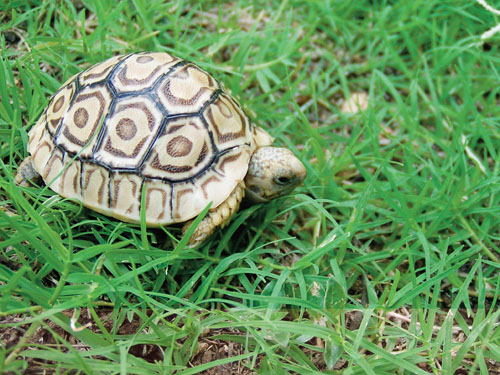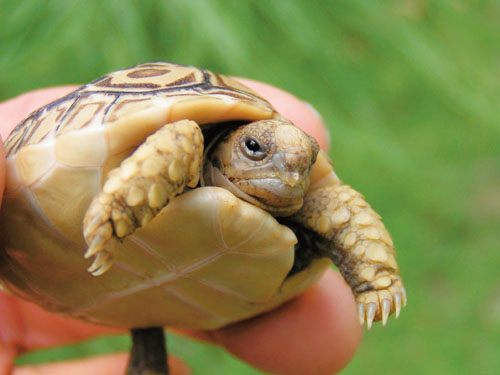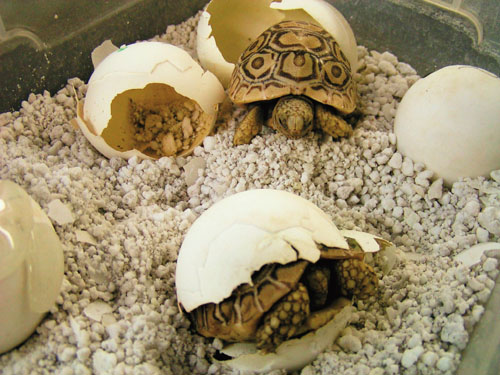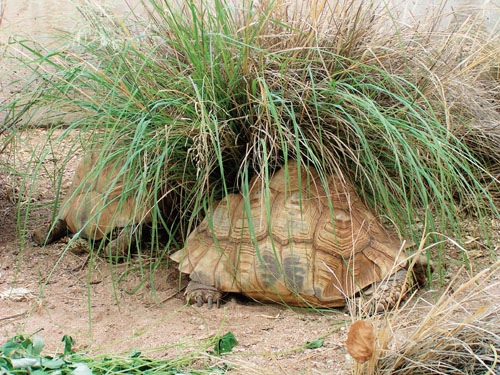Stigmochelys pardalis will thrive in captivity and become very personable pets.
 The leopard tortoise (Stigmochelys pardalis) is a brightly colored, high-domed, medium-to-large tortoise. It has been popular in the pet trade for many years. Found from Sudan in the northern part of Africa to the Cape in South Africa, leopard tortoises typically inhabit savannas and are not seen in humid rain forests or dry deserts. This species is currently known by two subspecies, Stigmochelys pardalis pardalis and Stigmochelys pardalis babcocki. For many years, it was included in the genus Geochelone, but it is now considered its own genus.
The leopard tortoise (Stigmochelys pardalis) is a brightly colored, high-domed, medium-to-large tortoise. It has been popular in the pet trade for many years. Found from Sudan in the northern part of Africa to the Cape in South Africa, leopard tortoises typically inhabit savannas and are not seen in humid rain forests or dry deserts. This species is currently known by two subspecies, Stigmochelys pardalis pardalis and Stigmochelys pardalis babcocki. For many years, it was included in the genus Geochelone, but it is now considered its own genus.

Richard Fife
Generally, about 150 square feet is suitable for one adult tortoise and an additional 75 square feet of area for each additional tortoise.
There is a wide array of colors, shapes and sizes of leopard tortoises found throughout their range. Because this species is so varied, some people have thought that there should be several subspecies. Recent DNA work, however, suggests that the two subspecies are probably not valid and that this is just a single species without any valid subspecies.
The largest leopard tortoises come from the northern limits of their range in the Sudan, Ethiopia and Somalia, where 26- to 28-inch tortoises are not uncommon, and there are reports of tortoises more than 39 inches long, thus making it the fourth largest tortoise species. In the extreme southern part of its range, in the higher elevations of South Africa, leopard tortoises also get quite large and can grow to about 24 inches. Between the northern and southern limits, there are populations of adult tortoises that grow no more than 12 inches. The average leopard tortoise available in the United States will grow to about 14 to 18 inches.

Richard Fife
Your leopard tortoise will grow around 2 to 4 inches a year, depending on temperature and diet, so plan on providing a larger enclosure as your hatchling tortoises grow.
It is also interesting to note that in some populations, females are larger than males, and in other locations, males are the larger sex. Leopard tortoises available in the United States originated from Kenya and South Africa. To my knowledge, none of the giant leopard tortoises from the Sudan, Ethiopia or Somalia have ever made it to the U.S.
In 2000, importation of leopard tortoises into the U.S. was banned, due to the possibility of heartwater disease making its way to the U.S. on a leopard tortoise. It was feared that the tortoises may spread the African tick harboring the disease and infect the U.S. cattle, goat and sheep industry. As of July 17, 2001, federal law requires that any leopard tortoise, African spurred tortoise or Bell's hinge-back tortoise transported across any state line be examined by an accredited veterinarian and certified tick-free.
Buy Captive-Bred Babies
Large leopard tortoises have a difficult time adjusting to new environments, but hatchlings seem to be able to adjust to a wide range of conditions. Most of the leopard tortoises imported from the wild years ago had a very difficult time adjusting to their new homes, and with the stress of importation, most did not survive. Captive-hatched leopard tortoises have a very high survival rate and have even adjusted to the dry deserts of Arizona and the humid summers of northern Virginia when protected from extreme heat and cold.
I recommend purchasing a tortoise that is less than a year old. Older, captive-raised tortoises will usually adjust to a new home, but it may take several months or more. Tortoises should have bright eyes, a good weight and be active when picked up. Your setup should be ready for your new acquisition before you bring it home.
Captive Needs
I don't think it matters whether or not you maintain a single tortoise or a group of tortoises. I have observed a pair sleeping under the same thorn bush in the wild, but more often, they are observed grazing as single animals. They seem to do fine in groups without much male to male combat if raised together. If a new male is introduced into the group, there can be some sparring, so watch them to be sure sparring doesn't get out of hand, such as one tortoise inflicting injuries to the other or one tortoise being flipped over. If such incidents do happen, you need to separate the animals.
Your tortoise will grow around 2 to 4 inches a year, depending on temperature and diet, so plan on providing a larger enclosure as your tortoise grows. Start with something simple, like an aquarium (a breeder tank has more floor space), tortoise table or plastic box measuring at least 16 inches wide, 24 inches long and 4 or more inches tall for one or two hatchlings. As the tortoise grows, you can move it to a plastic tub, such as a concrete mixing tub or a tub specifically made for turtles and tortoises. Once the tortoise is 4 to 6 inches, it should be moved to an outdoor enclosure if possible. Provide as much room as possible. Generally, about 150 square feet is suitable for one adult tortoise and an additional 75 square feet of area for each additional tortoise. If the grass in their yard is holding up to their grazing, you have sufficient room. If not, you should enlarge the enclosure or reduce the number of tortoises. Be sure there are hiding places and that shade is available at all times. If the tortoise can't get out of the sun, it will overheat and die.
Leopard tortoises don't dig, other than when nesting, so you don't need to bury the fence surrounding an outdoor pen in the ground. Almost any solid fencing material will work. The tortoise will pace the fence line if it can see through the fence, so I don't recommend chain-link or wire fencing unless you have plantings along the fence line. A tortoise hut is also used by leopard tortoises (in the wild, they may retreat into animal burrows). The hut should be heated if you expect to leave the tortoise outside during cooler months, and large enough to house all your tortoises comfortably. If your winters are damp, wet and cool, then your tortoises must be maintained inside during those months. They don't do well in cool, damp weather.
Leopard tortoises can deal with a wide range of temperatures, but until they have adjusted and put on some weight, it is best to keep them in optimum conditions. Nighttime temperatures should be between 78 to 84 degrees Fahrenheit. Daytime temperatures should be 82 to 86 degrees with a basking spot of 88 to 92 degrees. A heat lamp or ceramic heat emitters can help you achieve these temperatures. It is also suggested that an ultraviolet bulb be provided during the day. Provide 12 to 14 hours of light a day.
Throughout most of the leopard tortoise's range, they do not brumate, but instead remain active all year. In the southern part of the leopard tortoise's range, they may brumate in animal burrows during the coldest part of the year. Given that the locality of most captive leopard tortoises is unknown, it is not recommended that they be allowed to brumate. Even tortoises from South Africa should be kept active all year, as it is not known how much cold they can tolerate and remain healthy.
There are many good products that can be used for bedding, but I do not recommend sand. If eaten, it can result in gut impaction, and ultimately, death. I use alfalfa hay as bedding, but other grass hays work fine. You also need to provide a humid hide box. The humidity level within it should be between 60 and 80 percent. A plastic shoe box measuring 12 inches long, 6 inches wide and 4 inches tall works well. Cut an opening in the side just large enough for the tortoise to fit comfortably, and place an inch or two of slightly moist peat moss (not green floral moss) or ground coconut husk in the box. This added moisture will help the tortoise develop a smooth shell. If your tortoise is kept too dry during rapid growth, it will develop pyramiding, which is not desirable. Pyramided shells are bumpy and distorted in appearance.
Your tortoise may be shy and not very active until it adjusts to its new home. You can help it adjust by feeding it the same time every day. After it has had time to warm up, place the tortoise directly in front of its food. In the wild, leopard tortoises are a grazing species. If possible, a grass yard is recommended for your tortoise. If a grass yard is not available for all or part of the year, their diet can be high-quality greens, such as a spring salad mix, and a good commercial tortoise diet that offers 15 percent protein. Hatchlings require 15 to 20 percent of their diet be of protein. Include grated carrots, grass clippings (free of fertilizer and pesticides), dandelions, chopped peppers, cilantro, rose pedals, hibiscus flowers, spineless prickly pear cactus, nasturtiums, grape leaves and other tender plants in your salad mix.
Avoid feeding dog or cat food, or large amounts of fruit. A little fruit is fine, but only offer it on rare occasions, no more than once or twice a month, as a treat. Too much fruit will result in runny stools and provide a great place for parasites to thrive in the tortoise's gut. Fruit is also lacking in protein. Protein contains amino acids, which are the building blocks for a hard and healthy shell. For the tortoise, most of the required protein can be obtained from quality greens, many of which contain about 15 to 20 percent protein.
Raise hatchlings inside and feed them at least once a day. Their diet should include the high-quality greens and other foods described above. Keep in mind that these little guys don't have much biting power, so use very tender vegetables and chop them up. It is sad to see a little tortoise spend hours chewing on a lettuce leaf and never get anything down. If you are providing a high-quality, commercial tortoise diet, then vitamin and mineral supplements are not necessary. If you use vitamin and mineral supplements, it is generally best to do so sparingly and follow the directions on the product. If weather permits (not too hot or cold), put your tortoises outside for an hour or so every day, but remember they must be supervised and not left in direct sun.
One of the best diets for these grazing tortoises is a yard of Bermuda grass. There are many safe plants that can be included in your tortoise yard. Various species of clump grass or fountain grass are a must (don't use pampas grass, as it has serrated blades, which will cut your hands and arms as you try to retrieve a tortoise to bring it in for the night). Leopard tortoises love to plow into a large clump of grass to hide and retreat from the elements. The fountain grass will insulate the tortoise on cool nights. Your tortoise yard can include things like grape vines, hibiscus flowers, acacia trees and spineless prickly pear cactus. If you are unsure if a plant is toxic, research it before putting it in your tortoise yard.

Richard Fife
Once the baby tortoises have hatched and absorbed their yolk sac, move them to their enclosure.
To keep your hatchling tortoises hydrated, soak them in slightly warm water once a day. The water should only be about 3/8 of an inch deep for a hatchling. The tortoise will drink and then defecate in the water. If the tortoise is soaked daily, then a water dish is not necessary. I have found that a water dish usually just makes a mess. The activity rate of a new hatchling will increase as it grows and has become more adjusted to its new home. Don't worry if it sleeps a lot for the first several days.
Reproduction
Once tortoises are about 6 to 8 years old and are longer than 12 inches, they will be sexually mature and capable of reproduction. Size is more important than age, but size will depend on where the tortoise originated. Sexual activity will begin a year or two before the tortoises are capable of reproduction. They will go through the motions, but no eggs will be produced. There are environmental cycles, which trigger the reproduction process. It is believed that the annual shortening and lengthening of the daily photoperiod, the rainy season and annual temperature changes (in some cases very slight) play a role in reproduction. These cycles may vary from one geographical population to another. Just observing mounting or breeding activity doesn't necessarily mean eggs will be produced, but if the female has cycled, expect eggs four to six weeks after breeding. Leopard tortoises can lay from one to seven clutches of eggs a year (three clutches are the average for my tortoises).

Richard Fife
Outdoor tortoises require hiding places and shade available at all times. If they can't get out of the sun they may overheat and die.
Nesting usually begins in the late afternoon and is completed at dusk. The whole process takes about three hours. The female will dig a flask-shaped hole with her hind legs. This is done by starting a typical hole and then discharging water into the hole. This water will soften the bottom of the hole, allowing her to flare out the bottom, creating a nest cavity. It is important that the female is well hydrated, so she will have ample water in her body to complete this process. The female will carefully deposit seven to 21 round, hard eggs into the hole. If the female is well-hydrated, she will be able to produce a mucus slide, which helps prevent the egg from dropping into the hole, resulting in broken eggs.
After depositing her eggs, the female will bury the nest and attempt to hide the excavation site. Many hobbyists who work with leopard tortoises from the southern part of their range will leave the eggs in the ground to overwinter and hatch naturally the next summer or fall. Eggs laid by the southern race of leopard tortoises are laid in a state of diapause, in which egg development is suspended during colder months. The eggs are fertile, but will not begin to develop until an environmental trigger breaks the diapause. Overwintering the eggs in the ground (don't allow them to freeze) seems to be an effective way to break diapause, and the eggs begin to develop when the ground warms up.
Eggs laid by leopard tortoises in the more northerly parts of the range are not laid in a state of diapause and can be immediately placed in an incubator for development to begin. It can take five to 14 months for them to hatch. It is assumed that leopard tortoise eggs are temperature-sex determinate. This means that the incubation temperature of the eggs will determine the sex of the hatchlings. In many tortoise species, females are produced at the high end of the incubation temperature scale and males at the low end. I am not aware of any studies done with leopard tortoises, so I can't recommend a specific temperature to produce all females or all males. Incubation temperature can range between 82 to 88 degrees Fahrenheit, but it may require 90 degrees to guarantee females. Research has shown that African spurred tortoises required 90 degrees to guarantee females, but research is needed to verify this in leopard tortoises.
Place the eggs in a plastic shoe box, and sink one third of their diameter in perlite or vermiculite (vermiculite manufactured after 1990 should be asbestos-free), 1 part water to 11/2 parts media by weight. Once the baby tortoises have hatched and absorbed their yolk sac, move them to their enclosure. It may take a few days for the babies to start eating, but if you keep them at 82 to 86 degrees during the day and provide a hide box, they should start eating within about three to seven days.
Leopard tortoises will thrive in captivity and become very personable pets. I highly recommend them if you can provide the proper care. They can provide many years of enjoyment for their owners, whom they will likely outlive. REPTILES
A Question of Color
Leopard tortoises are marketed by many appealing and descriptive names, but many of these color "morphs" are not genetic. Under captive conditions, a normal hatchling leopard tortoise can develop lots of white, which is not its normal pigmentation. It has been found that by accelerating the growth of a leopard tortoise, normal pigmentation is not produced. The resulting tortoises are very attractive, but the coloring is not a true genetic trait that can be passed on to the next generation. There are, however, some true genetic, hypo-melanistic (less-than-normal melanin) tortoises, which can be identified as hatchlings.
Richard Fife has bred reptiles for more than 40 years and leopard tortoises for more than 32 years. He is the owner and operator of Riparian Farms, a turtle- and tortoise-breeding facility. Visit him at ivorytortoise.com.

